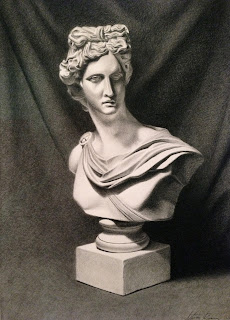I prepared the canvas with about 10 coats of gesso and light sanding in between the last few coats. It's not worth posting a photo of a blank canvas. The process is tedious, but its makes a big difference. The surface is smooth which is what you want to get the smooth gradients in oil and details which really make the painting stand out.
I recently purchased a projector and decided to transfer the photo to the canvas using this method. I can get a lot more detail and a more accurate transfer using the projector. Doing the sketch was not a waste of time. I found it got me more familiar with the photo and it made the transfer to the canvas much easier.
I used spray fixative to seal the graphite transfer and this worked very nice. No smudging!
This is the first layer. I oiled in the whole canvas with linseed oil and applied one light coat of yellow ochre. I mix the yellow ochre with some turpenoid to thin it out. I use a fan brush (dry) to smooth out the tone. Wait for this to completely dry before proceeding to the steps. It takes at least a week.
Next start in with Burnt Umber under painting.
Burnt umber layer is complete.
Next start in with the gray scale. Since this photo was originally black and white I think I am going to leave the painting in black and white and not try and colorize it.
The is just the first layer and you can still see some of the burnt umber showing through. I need to ignore the white hair and details for now and lay in darker tones first then come back later to put in the white hair (like in the eye brows).
I added in the hat, some background and the under layer for the beard. This is difficult because I need to once again ignore the white hair and get the tones beneath the beard.




















































